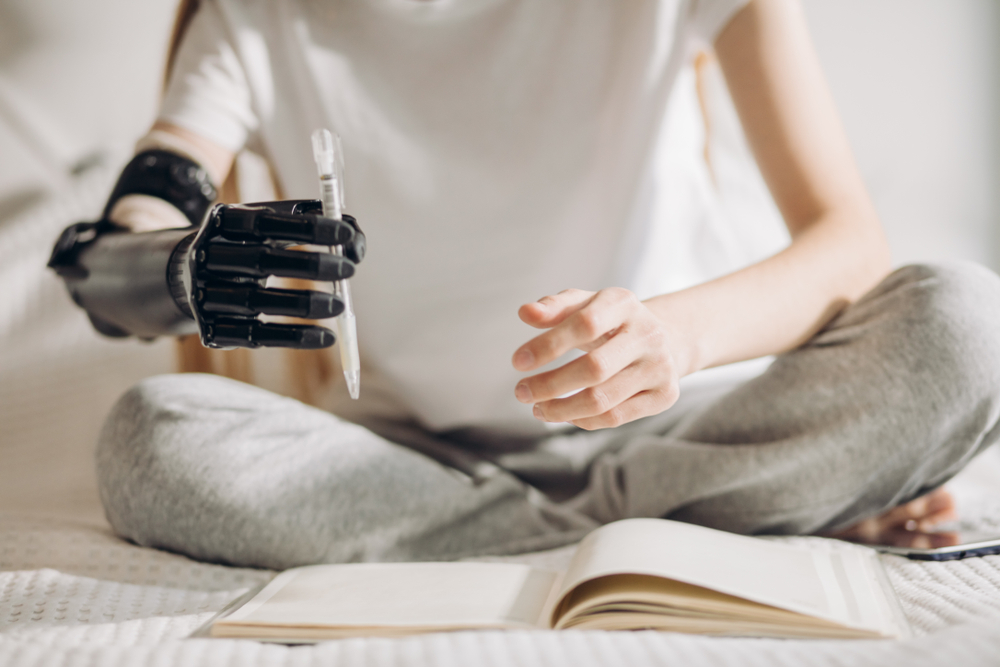Sarah de Lagarde, 44, has become one of the first people in the world to receive an AI-supported bionic arm.
In September 2022, Sarah slipped on a rain-soaked platform in London’s Underground, falling under a moving train. Despite medical intervention, her arm and leg couldn’t be salvaged.
An AI-powered bionic arm engineered by UK company Covvi has granted her a near-natural range of movement in the arm, which will eventually be extended to the fingers.
She describes herself as “80% human and 20% robot” and joins a handful of individuals worldwide who have regained some level of natural movement in their injured limbs thanks to advanced prosthetics.
The National Health Service (NHS) provided de Lagarde with a prosthetic leg, but an arm wasn’t readily available. She looked into private options, but costs soared above £300,000.
De Lagarde initiated a fundraising campaign, and the response was overwhelming. She said, “I thought we would raise £10,000, but the money started pouring in,” and eventually received enough money to approach Covvi, an industry-leading prosthetics company specializing in upper-body limbs.
How does it work?
When someone loses a limb, healthy nerve endings remain in the injured stump.
These nerve endings generate myoelectric signals in the muscles, which can be picked up by electrodes and converted into artificial electrical signals passed into the motors of the artificial limb.
In between, algorithmic processing translates myoelectric signals into physical actions. When de Lagarde thinks of performing a specific movement, muscle movements within her elbow are detected and converted into actions by AI software embedded in the prosthetic limb.
In turn, the bionic arm and hand can perform the movement she desires, and over time, the AI system refines the movements to improve accuracy.
“There are two sides to AI. One is potentially quite frightening, but on the other hand, excuse the pun, it can give me a piece of my life back,” she stated – a pertinent point amid discussions around AI’s detrimental risks to humanity.
View this post on Instagram
AI is powering the next generation of advanced prosthetics and brain-machine interfaces, including a device that enables a paralyzed man to move his legs again.
Gert-Jan Oskam broke his neck in 2011, suffering complete paralysis in the lower body. An AI device connected to his brain passes electrical signals across the injured part of his spine to stimulate the leg muscles.
Another recent experiment involved combining brain implants with machine learning to re-link damaged parts of the brain and spinal cord to enable a paralyzed man to regain some movement and sensation in his limbs.
In de Lagarde’s case, operating the bionic arm will feel increasingly natural with practice, responding to tiny muscle twitches detected by sensors to grant her the ability to hold an egg or pick up a coin.
Before the device was fitted, Sarah underwent rigorous training to tune and optimize the functionality of her new limb, including learning how to flex the arm and rotate the wrist.
How does AI facilitate bionic artificial limbs?
Advanced motorized prosthetics that respond to electrical activity in the injured limb are over a decade old, but machine learning (ML) has vastly accelerated their performance.
Here’s how it works:
- Muscle movement detection: The prosthetic limb is equipped with electrodes that pick up weak electrical signals originating from muscle movements within the user’s injured limb when they think about performing an action. These detected and amplified muscle signals are transmitted to a mini-computer embedded within the prosthetic limb.
- Signal interpretation: A mini-computer mounted on the limb or the body runs a machine learning algorithm to interpret the received signals, decoding the user’s intended action based on these electrical impulses. ML techniques can accurately recognize and classify the patterns of electrical signals in sufficient detail to enable advanced movement.
- Action execution: The interpreted signals are transformed into commands that control the prosthetic limb’s motors, causing the hand and arm to perform the desired action. This could range from lifting an object to rotating the wrist or opening the hand.
- Continuous optimization: The AI software learns to anticipate the user’s most common movements, making the process more efficient and fluid over time.
Prosthetic limbs will eventually grant the ability to feel in addition to facilitating complex actions such as grasping and manipulating small objects.
AI has become integral to the process of bridging the gap between technology and the nervous system, which opens a world of opportunity for medical rehabilitation.
In time, technological and biological systems will likely become almost entirely homogeneous, communicating naturally.





